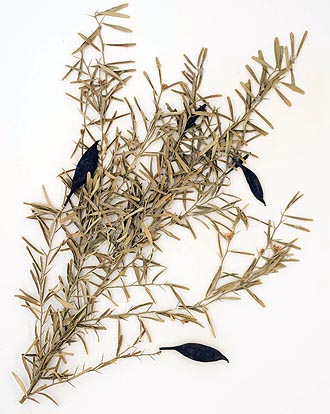

formerly
The following description and drawing is from the journal 'Baileya. A quarterly journal of Horticultural Taxonomy' 1976.
"Fruits cylindric, slightly curved, abruptly beaked at apex and abruptly narrowed at base, 5-8 cm long, 1.0-1.3 cm thick at broadest part, green to yellow at full maturity, 3-5-celled, each cell usually containing 5 seeds."
"Fruits with strong odor of limes when crushed."
"Branchlets when young are minutely pubescent and angular"
"Fruits with strong odor of limes when crushed."
"Branchlets when young are minutely pubescent and angular"
Department of Forests, Brown River.
Shrub to 1.5m; leaves tiny; slender, spiny twigs; fruit 1.3cm X 6.35cm, yellow at maturity. Wild.
Shrub to 1.5m; leaves tiny; slender, spiny twigs; fruit 1.3cm X 6.35cm, yellow at maturity. Wild.
Type Specimen

From the Australian Virtual Herbarium, the blue dots on the map show collection locations of Citrus wintersii.
Potted plants labelled as 'Microcitrus papuana' have been quite widely distributed in Europe. These originate from Italy, having been introduced by the Italian citrus research centre in Acireale. Propagation material was sent to there from the Florida Department of Agriculture in Winter Haven in 1989, having been provided by the original collector H.F.Winters.
Courtesy of the U.S. National Arboretum Herbarium (NA).

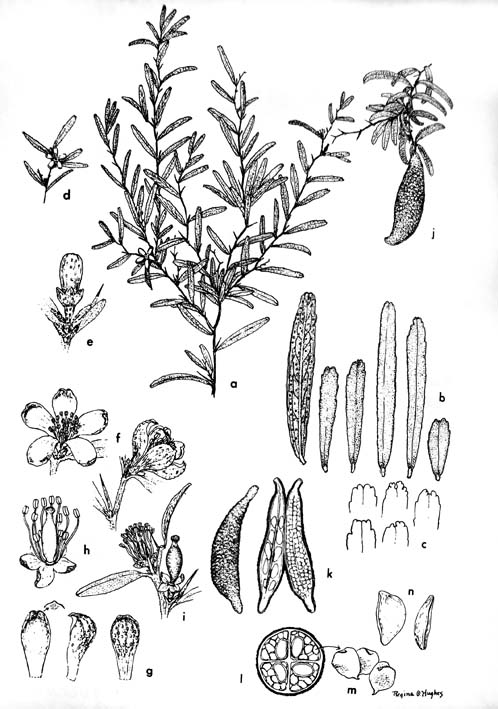
Until 1960 there was only one native species of Microcitrus known in Papua New Guinea. This was Microcitrus warburgiana, closely related to the Australian species Microcitrus austalasica and Microcitrus australis.
All these have now been botanically returned to the true citrus group and are re-named Citrus warburgiana, Citrus australasica (finger lime) and Citrus australis (round lime).
However, samples from a different species had been collected in Papua New Guinea on several occasions in the 1960's, but it was only in 1970 that a full botanical description was made by the collector H.F. Winters. At first this species was named Microcitrus papuana, but David Mabberley of the Royal Botanic Gardens in Sydney, later re-classified it as Citrus wintersii in honour of its collector.
"A curious citrus-like shrub, 1m - 2.4m tall, growing naturally in the transition area between eucalyptus savanna and tropical rain forest at the Forestry Station, Brown River, Central District, Papua New Guinea."
"Leaves very variable on individual plants. 15mm to 28mm long, 2mm to 6mm wide, medium to dark green."
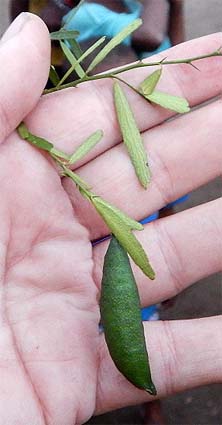
In 2014, the intrepid citrus plant collector Sylvain Jousse found Citrus papuana in the Port Moresby area. The plant, leaves and fruits clearly fit the botanical description shown above.
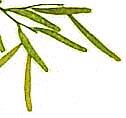

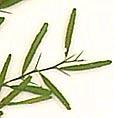

Herbarium specimens from early Papua New Guinea collections are in Canberra, Australia and Washington, USA. The first four pictures below are details from the Canberra Herbarium collections. The last two are from the U.S. National Arboretum Herbarium, and high definition copies of these are available to study by selecting the small images. Texts are copied from the herbarium sheets. Colours are not true to the living plant. All pictures reproduced with permission.
Shrub in undergrowth of rainforest, up to 5 feet high. Leaves dark green. Flowers pale yellow. Fruits dark green. Brown River, Central District, Papua.
I mile SW. of Edebu, Brown River
Eucalypt-savanna remnant on top of hill.
Spiny low shrub, up to 0.5m tall.
(Only one bud found).
Eucalypt-savanna remnant on top of hill.
Spiny low shrub, up to 0.5m tall.
(Only one bud found).
Brown River forestry area, c. 22 miles N. of Port Moresby. Inside margin of gully rainforest adjacent to Eucalypt savannah. Alt c. 120 feet.
Spiny shrub c. 6 feet tall, though usually 3-4 feet. Often 3-4 stems arising from a common rootstock at ground level. Crushed leaves with a distinct citric smell. Flower buds cream, single in the axils. Flowers with pale green calyx, 5 white petals, c. 20 stamens. Anthers yellow on white filaments. Pistil yellow-green. A single fruit found, green, elongated round in x-section and rather beaked apically.
Spiny shrub c. 6 feet tall, though usually 3-4 feet. Often 3-4 stems arising from a common rootstock at ground level. Crushed leaves with a distinct citric smell. Flower buds cream, single in the axils. Flowers with pale green calyx, 5 white petals, c. 20 stamens. Anthers yellow on white filaments. Pistil yellow-green. A single fruit found, green, elongated round in x-section and rather beaked apically.
Brown River Central District
Habitat: Forests
Habit: Shrub, 2m.
Habitat: Forests
Habit: Shrub, 2m.
These European plants have the expected linear leaves, but seem to rarely fruit. The few images of the fruit look a bit similar to the fruits grown at the Citrus Variety Collection, Riverside, California - and these are clearly not true to the original type either. Some hybridisation seems to have taken place en route to California and Europe!
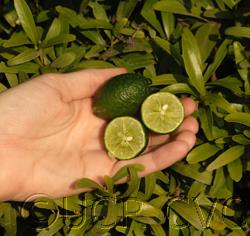
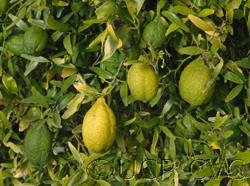
Italian Variety: Microcitrus papuana
Clone: CSSA 0-35-1
Selection: ISA Code: MPA 0001
Ministerial list: 22 03 2001
Clone: CSSA 0-35-1
Selection: ISA Code: MPA 0001
Ministerial list: 22 03 2001
From UCR CVC website (permission requested): "Seed collected at DPI Arboretum" (now Florida Citrus Arboretum) "Although these were seed introductions, the fruit and foliar morphology matches the published description" In my opinion this is wrong - the fruits in these photos from California do not match the original description of Microcitrus papuana!

From various French and Italian websites:
the fruits in these photos do not match the original description of Microcitrus papuana
the fruits in these photos do not match the original description of Microcitrus papuana
My own potted specimen, said to be Microcitrus papuana but probably also some hybrid, died years ago. However it did once form some very unusual flowers, with the petals emerging as thin filaments not covering the stigma. Out of interest, these enlargements are shown below.
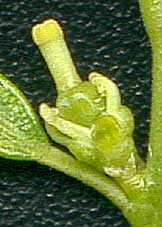


These images are greatly enlarged, the smaller buds being only 1mmx2mm, the largest 3mmx6mm.
The tiny buds emerged entirely light green and round. The stigma and immature fruit then poked out of thin separated petals which turned from green to white.
The tiny buds emerged entirely light green and round. The stigma and immature fruit then poked out of thin separated petals which turned from green to white.
page updated 8th December 2016
and 4th & 18th October 2019
and 4th & 18th October 2019

From an Italian nursery, here the label photo clearly shows a finger lime, Citrus australasica.
the flowers in these photos do not match the original description of Microcitrus papuana
European suppliers of Microcitrus papuana are Italian citrus nurseries Agrumi Lenzi & Tintori. In June 2018 Lenzi reported their first fruits of this variety. As can be seen in the photo the fruits are rather fatter, straighter and less tapered than the original description. The flowers seem to match those of my deceased specimen - nothing like the flowers originally shown in the Baileya article.

Agrumi Lenzi writes:
i fiori sono molto piccoli quasi invisibili
the flowers are very small, almost invisible
i fiori sono molto piccoli quasi invisibili
the flowers are very small, almost invisible
Once again, probably hybrids

R. Pullen 24 April 1967
P.van Royen
24 Jan 1963
24 Jan 1963
P.C.Heyligers
18 June 1965
18 June 1965
H. F. Winters & J. J. Higgins
26 March 1970
26 March 1970
K. J. White
30 May 1974
30 May 1974
Click the small images above for the full herbarium sheets in high definition.
Herbarium specimens from Florida following H.F. Winter's introduction from Papua N. G. in 1970. Click the pictures below for higher definition images
All the above show leaf form, flowers and fruits which exactly match plants growing in their native habitat in Papua New Guinea. Images from various herbaria via senecportal.org
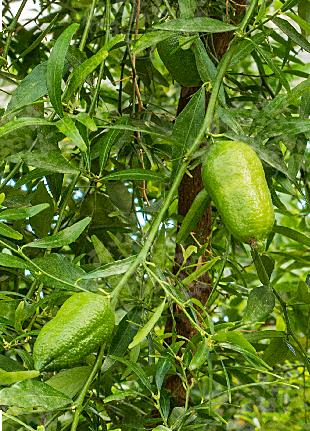
From Agrumi Lenzi
From Oscar Tintori




